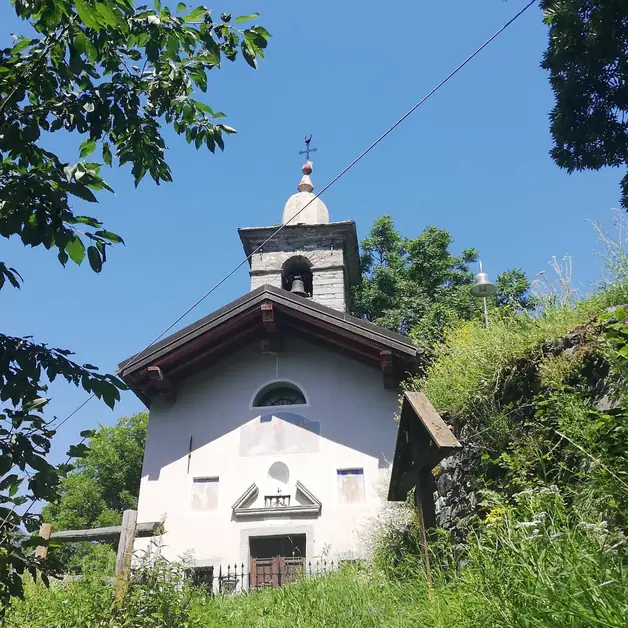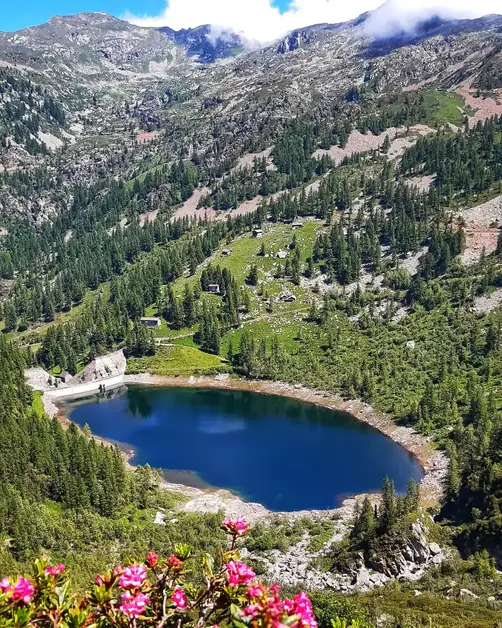The Chapel of San Francesco di Sales in Fontainemore
The Chapel of San Francesco di Sales is a place of faith and tradition in Fontainemore.

Where is the Chapel of San Francesco di Sales located?
The Chapel of San Francesco di Sales is located in the Pillaz area of Fontainemore, in the Aosta Valley. It is situated slightly downstream from the oldest part of the village and stands out on a panoramic ridge, among terraces supported by typical dry stone walls. This suggestive position allows visitors to admire the valley below and the surrounding mountains, offering a place of peace and contemplation immersed in the alpine nature.
What is the landscape surrounding the chapel?
The chapel stands in a rural environment that was once entirely cultivated with cereals. The terraces, now used for grazing, tell the story of a territory shaped by man over the centuries. The dry stone walls, built without mortar, are a masterpiece of balance and craftsmanship: they served to support the land and create cultivable surfaces even on the steepest slopes. Today, these structures represent a living testimony of the Aosta Valley's peasant culture.
To whom is the chapel dedicated and why?
The Chapel of Pillaz is dedicated to Saint Francis de Sales, Bishop of Geneva and patron saint of journalists, whose feast is celebrated every year on January 29. The choice of this saint, belonging to the winter period, is not accidental. It reflects the needs of the local community, deeply linked to seasonal emigration. Many men would leave in spring to work in construction in other regions and return only in autumn. By celebrating the saint's feast in winter, the community could gather in full, involving even the emigrants who returned home.
When was the Chapel of San Francesco di Sales built?
The chapel probably dates back to the 19th century, although its exact date of construction is not precisely documented. It fits into the context of the numerous rural chapels that arose in the small villages of the Aosta Valley, built as a sign of devotion and a point of reference for the religious life of mountain communities. Its simple and harmonious architecture reflects the traditional style of mountain buildings, using local stone and wood.
How is the chapel structured and what are its main elements?
The Chapel of San Francesco di Sales features a sober yet elegant facade, with a stone portal and a small bell tower that stands out against the sky. The interior is intimate and cozy, preserving an altar dedicated to the titular saint. The decorations are simple but rich in meaning, contributing to creating an atmosphere of deep spirituality. In many cases, as in this chapel, the furnishings and sacred images have been donated by the inhabitants themselves as a sign of faith and gratitude.
Why is the feast of San Francesco di Sales important for the inhabitants of Fontainemore?
The feast on January 29 represents a moment of strong community identity. It is a celebration that unites religion, tradition, and collective memory. In the past, the feast was also an opportunity to reunite after months of separation and share the fruits of work done outside the village. Even today, the celebration is felt and participated in, a sign of the deep bond between the population and their roots.
What connection exists between the Chapel of Pillaz and the Fontainemore Procession to Oropa?
The Fontainemore Procession to the Oropa Sanctuary today departs from the Chapel of Pillaz, a tradition that has its roots in the 17th century. Until 1974, the chapel was the first stop of the pilgrimage that started from the parish church. This long and demanding procession crosses mountains and valleys, carrying with it religious symbols such as the Pastoral and the Cross.
What happens upon the return of the procession from Oropa?
Upon the return of the pilgrimage, when the Pastoral and the Cross appear above the chapel of Pillaz, the villagers begin to ring the bells in celebration. The sound, echoing among the mountains, announces the return of the pilgrims and is welcomed by the bells of the parish church, which respond with the same enthusiasm. It is a moment of great emotion and deep communion between faith, territory, and community.
What is the significance of the Fontainemore Procession to Oropa for the local population?
The procession represents one of the most heartfelt religious and social events in the Lys Valley. It takes place every five years and involves hundreds of people who walk over 80 kilometers to the Piedmontese sanctuary of Oropa. It is a gesture of collective devotion, but also of identity and belonging. The passage in front of the Chapel of San Francesco di Sales symbolically marks the beginning and end of the spiritual journey.
How to reach the Chapel of Pillaz in Fontainemore?
The chapel can be easily reached by car or on foot. From Aosta, take Regional Road 44 towards Gressoney-Saint-Jean. After passing Fontainemore, follow the signs for the Pillaz area. It is possible to park near the village and continue on foot for a short stretch on a path that climbs through the meadows and dry stone walls. Walking from the village center takes about 30 minutes and is suitable for families.
What makes a visit to the Chapel of San Francesco di Sales special?
Visiting the Chapel of San Francesco di Sales means discovering an authentic place, away from the most frequented tourist routes. It is an opportunity to breathe in the spirituality of the mountains and to understand how faith has shaped the daily lives of alpine communities. The view from the ridge, combined with the silence and the scent of the pastures, creates an intense and memorable experience.
Why is the Chapel of Pillaz important for the memory of the territory?
The chapel is not just a religious building, but an emotional reference point for the inhabitants. It symbolizes the link between the past and the present, between the generations that have inhabited these mountains and those who today preserve their history. It is a place that continues to unite the community, keeping alive the tradition and devotion of a people who have managed to maintain their spirit of belonging.
